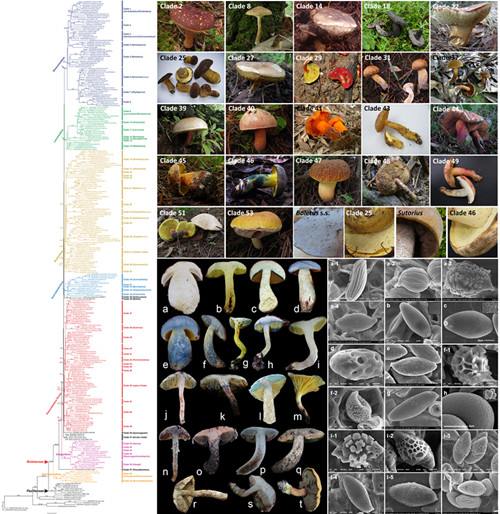Mushrooms in the basidiomycete family Boletaceae are ecologically and economically very important, and have long attracted the attention of mycologists from different parts of the world. Some of these boletes have great economic, dietary, and health value, and some other boletes are poisonous, predominantly causing gastrointestinal symptoms of nausea and violent vomiting if eaten raw or fried. Ecologically, most species of Boletaceae are important ectomycorrhizal (ECM) fungi in the ecosystem and can form ECM relationships with plants of more than 10 families. However, due to the morphological complexity and the limited phylogenetic information available on the various species and genera of this fungal family, Boletaceae was considered as one of the most complicated fungal groups. E. M. Fries, the founder of fungal taxonomy, even said “No genus has given me more trouble than that of the boleti.”
Recently, on the basis of the collections made in the past ten years, and in collaboration with other research groups at home and abroad, the Research Group in Fungal Diversity and Molecular Evolution headed by Prof. YANG Zhuliang. from Kunming Institute of Botany, conducted a molecular phylogenetic study of Boletaceae. In this study, DNA sequences of four genes (nrLSU, tef1-α, rpb1, and rpb2) were newly obtained from ca. 200 representative specimens of Boletaceae. Based on the molecular data and additional morphological and ultrastructural evidence, a phylogenetic frame of Boletaceae is proposed. The results have been published online in the journal Fungal Diversity (Wu et al. 2014. doi:10.1007/s13225-014-0283-8).
This study revealed seven major clades at the subfamily level, namely Austroboletoideae subfam. nov., Boletoideae, Chalciporoideae subfam. nov., Leccinoideae subfam. nov., Xerocomoideae, Zangioideae subfam. nov., and the Pulveroboletus Group. In addition, 59 genus-level clades were identified, of which 22 were uncovered for the first time. Among the known genera, 11 of them were proven to be monophyletic. The results further indicated that the characters frequently used in the morphology-based taxonomy of Boletaceae, such as basidiospore ornamentation, the color change of context when bruised, the form of the basidioma, and the stuffed pores each had multiple origins within the family, suggesting that the use of such features for high-level classification of Boletaceae should be de-emphasized and combined with other characters. Moreover, this study obtained 11 types of basidiospore ornamentations in family Boletaceae, two of which were reported for the first time.
This work was supported by the Funds for International Cooperation and Exchange of the National Natural Science Foundation of China (31210103919), the National Basic Research Program of China (2014CB138305) and the CAS/SAFEA International Partnership Program for Creative Research Teams.





